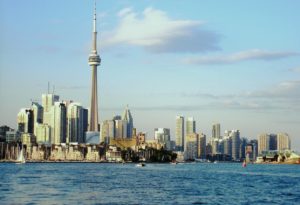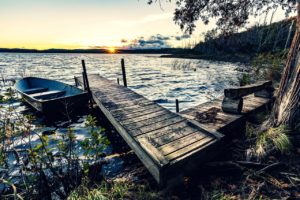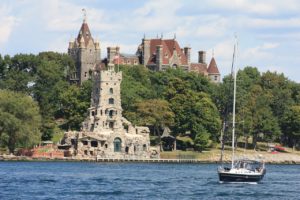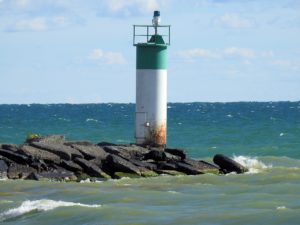
Lake Ontario is the smallest of the Great lakes in surface area at 7,340 square miles. It is the easternmost of the Great Lakes and it is also the 13th largest lake in the world. When its islands are included, the lake’s shoreline stretches to more than 712 miles. It is surrounded on the north, west, and southwest by the Canadian province of Ontario, and on the south and east by the American state of New York, whose water boundaries meet in the middle of the lake.
Ontario, Canada’s most populous province, was named for the lake. Many of Ontario’s most populous cities, including Toronto, Canada’s most populous city, and Hamilton, are on the lake’s northern or western shores. Its primary source of water is the Niagara River from Lake Erie. The last in the Great Lakes chain, Lake Ontario serves as the outlet for all the Great Lakes to the Atlantic Ocean via the Saint Lawrence River. It is also the only Great Lake not to border the state of Michigan.
Lake Ontario, although slightly smaller in area, is much deeper than Lake Erie, with an average depth of 283 feet. It has a water retention time of about 6 years. Major urban industrial centers, such as Hamilton and Toronto, are located on its shore. The U.S. shore is less urbanized and is not intensively farmed, except for a narrow band along the southern part of the lake.

The Canadian side of the Lake Ontario is home to more than 10 million people. More than 2 million people live in the American side of Lake Ontario. The American shore is largely rural, with the exception of Rochester and the much smaller ports at Oswego and Sacket’s Harbor. The city of Syracuse is 40 miles inland, connected to the lake by the New York State Canal System.
Nearly all of Lake Ontario’s islands are on the eastern and north-eastern shores, between the Prince Edward County headland and the lake’s outlet at Kingston. The Toronto Islands on the north-western shore are the remnants of a sand spit formed by coastal erosion, whereas the mostly larger eastern islands are underlain by the basement rock found throughout the region. The largest island is Wolfe Island, at the east end of the lake. It is accessible by ferry from both Canada and the U.S.

Lake Ontario drains into the St. Lawrence River, which ferries Great Lakes freshwater to the Atlantic Ocean. Before construction of the Erie Canal, Welland Canal, and St. Lawrence Seaway, natural barriers such as river rapids and Niagara Falls prevented or restricted the movement of both fish and boats into the upper Great Lakes.
Lake Ontario is surrounded by a mostly rural landscape, with forest covering nearly half of the basin. Development on the U.S. side leans heavily toward agriculture, while the Canadian shore sports more industrial areas and urban centers like Toronto, Ontario’s largest city. The lake’s link to the Atlantic Ocean drives activity at 13 major commercial shipping ports.
The Great Lakes Circle Tour and Seaway Trail are designated scenic road systems connecting all of the Great Lakes and the St. Lawrence River. As the Seaway Trail is posted on the U.S. side only, Lake Ontario is the only of the five Great Lakes to have no posted bi-national circle tour.

In the 1800s, there were reports of an alleged creature, similar to the so-called Loch Ness Monster, being sighted in the lake. The creature is described as large with a long neck, green in colour, and generally causes a break in the surface waves.
Fishing:
Summer fishing includes good catches of Salmon, Steelheads, and Lake Trout. Browns can be caught closer to shore. Fall brings the legendary runs of King Salmon and Cohos.
List of Cities and Towns on Lake Ontario:
Ontario, Canada:
Toronto, Mississauga, Hamilton, Burlington, Oshawa, Kingston, Whitby, Stoney Creek, Grimsby, Oakville, St. Catharines, Port Hope, Cobourg, Brighton, Pickering, Ajax, Bowmanville, Belleville, Trenton, Niagara-on-the-Lake
New York, United States
Rochester, Greece, Irondequoit, Webster, Oswego, Fair Haven, Sackets Harbor, Cape Vincent, Three Mile Bay, Wilson, Chaumont

Fast Facts about Lake Ontario:
- second smallest by volume
- average depth 283 ft. (86m)
- retention time = 6 years (a measure based on the volume of water in the lake and the mean rate of outflow)
- urban industrial centers (Hamilton and Toronto) on the Canadian side
- U.S. shore is less urbanized, not intensively farmed
